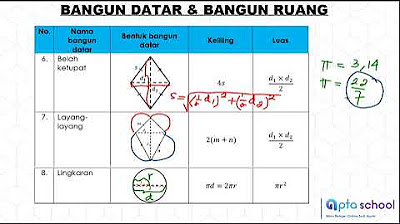KESEBANGUNAN DUA BANGUN DATAR
Summary
TLDRIn this video, Vivi introduces the concept of similarity in geometry, focusing on identifying when two shapes, such as rectangles, kites, or triangles, are similar. Vivi explains that to determine similarity, we must compare corresponding angles and proportional side lengths. Using examples, she demonstrates how to check these properties in rectangles, kites, and triangles. Vivi also offers a step-by-step guide to calculate unknown side lengths in similar shapes. The video includes exercises for practice, encouraging viewers to apply the concepts independently. A fun, interactive approach helps viewers understand and identify geometric similarity.
Takeaways
- 📐 Similarity in geometry requires two conditions: equal corresponding angles and proportional corresponding sides.
- 🔍 The example begins by comparing two rectangles ABCD and KLMN for similarity, checking both angles and sides.
- 📝 All corresponding angles of the rectangles are equal at 90°, fulfilling the first condition for similarity.
- 🔢 The sides of the rectangles are then compared, with proportional relationships like 1:2 between corresponding sides, fulfilling the second condition for similarity.
- ✅ The conclusion: rectangles ABCD and KLMN are similar because both conditions of similarity are satisfied.
- 🔄 For the second example, two kites ABCD and EFGH are compared for similarity, starting with calculating unknown angles.
- 📊 Both kites have corresponding equal angles, meeting the first condition for similarity.
- 🔗 The side lengths of the kites are proportional, with ratios like 3:2, satisfying the second condition for similarity.
- 📏 Another exercise compares triangles ABC and PQR, where corresponding sides and angles are identified based on their positions.
- 💡 The video emphasizes how to solve for unknown side lengths using the proportional relationships in similar shapes, concluding with practice problems.
Q & A
What is the first step in determining whether two shapes are similar?
-The first step is to check if the corresponding angles of both shapes are equal.
How do you check if two rectangles are similar?
-To check if two rectangles are similar, first confirm that all corresponding angles are equal (90° in this case). Then, compare the ratios of the corresponding side lengths to ensure they are proportional.
What is the symbol used to represent similarity between two shapes?
-The symbol used to represent similarity between two shapes is '∼'.
What are the two main criteria for two shapes to be similar?
-The two main criteria are: 1) Corresponding angles must be equal, and 2) The ratios of the corresponding side lengths must be proportional.
In the example given, what is the ratio of the sides AB and KM in the two rectangles?
-The ratio of sides AB and KM is 1:2.
How do you calculate the missing angle in a quadrilateral?
-To calculate the missing angle in a quadrilateral, sum all the known angles and subtract from 360°, the total sum of angles in a quadrilateral.
What is the ratio of side lengths in the two similar kites (layang-layang) ABCD and EFGH?
-The ratio of corresponding side lengths in the two kites is 3:2.
How do you determine which sides of two triangles correspond to each other when checking for similarity?
-To determine corresponding sides, check the sides that are between matching angles in both triangles and compare those sides.
What is the method to calculate unknown side lengths in similar shapes?
-Use the proportional ratios of corresponding sides. Set up a proportion using the known lengths, and solve for the unknown side.
What are the final steps in checking for similarity between two shapes?
-The final steps are to ensure that both the angles and the side ratios meet the required conditions for similarity. If both conditions are satisfied, the shapes are similar.
Outlines

Esta sección está disponible solo para usuarios con suscripción. Por favor, mejora tu plan para acceder a esta parte.
Mejorar ahoraMindmap

Esta sección está disponible solo para usuarios con suscripción. Por favor, mejora tu plan para acceder a esta parte.
Mejorar ahoraKeywords

Esta sección está disponible solo para usuarios con suscripción. Por favor, mejora tu plan para acceder a esta parte.
Mejorar ahoraHighlights

Esta sección está disponible solo para usuarios con suscripción. Por favor, mejora tu plan para acceder a esta parte.
Mejorar ahoraTranscripts

Esta sección está disponible solo para usuarios con suscripción. Por favor, mejora tu plan para acceder a esta parte.
Mejorar ahoraVer Más Videos Relacionados
5.0 / 5 (0 votes)






